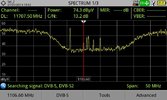Some photography edumacation to fill the pause.
The most important factor to get any pictures at all in my experiments has been
using a really sharp lens even if means the max aperture is smaller. I think it has
to do with how many pixels the light is spread over on the sensor. If four pixels
get all the light you get higher contrast over the background then if nine pixels
or more share the light. You can't get less than four pixels anyway, the sensors use a
"Bayer matrix" to compute the colors that end up in the RGB-values in the finished
image. There might be tricks to get more resolution directly from the raw image
data when converting it to B/W, checking that is halfway down the to-do-list.
The creative paperwork on the lens hood reduced the unwanted straylight by half.
Reflections in a neighbours white fence (lit by streetlights) was added to the light
pollution. A lens with good initial contrast can have trouble with internal reflections
that lowers the contrast if the exposure time is hundreds of seconds compared to just
seconds. Even the tiniest bit of light entering the lens from the side (outside the image
area) will ruin the contrast.
The tripod is a Manfrotto 144B with a 141RC video head. Old stuff and probably
replaced by newer versions now, the video head is also called a "three way head".
Really useful for any kind of photography where stability is neccesary, just a bit
heavy to carry around. The "roll-axis" adjustment can align the camera parallell to
the satellite belt, makes it easier to zoom in and search by just scrolling left/right
instead of going diagonally.
Some android applications using the smartphone sensors to show compass and level
information will be tested soon. If the metall in the tripod doesn't disturb too much
it will make aiming much easier.
The remote control is from Hähnel has a nice function when using B (bulb) for
long exposures.
... yes the grass is still green and growing here. What a silly season!






